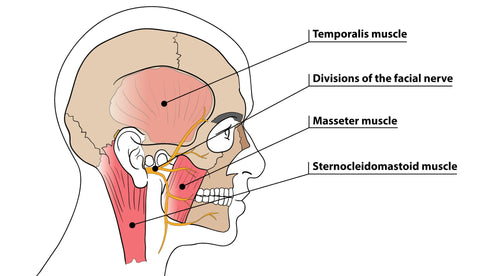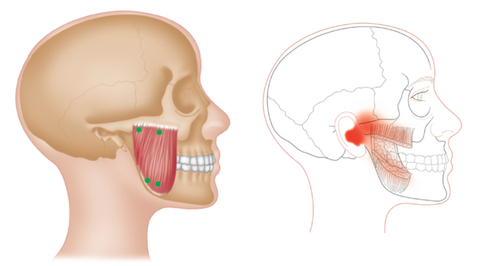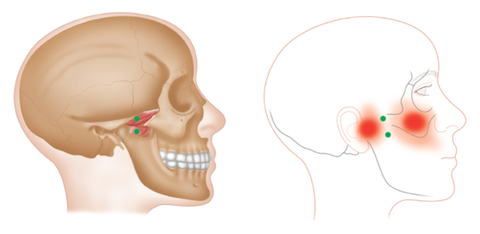Temporomandibular Joint Disorders (TMJD) and Bruxism

It is estimated that 20–30% of the adult population will have TMJ problems at some point in their life
TMJD disorder is sometimes called the ‘Great Impostor’ because of the multiplicity of symptoms.
Pain, stiffness, clicking, clunking or popping sounds, and aching in the jaw muscles characterize this debilitating problem.
Classically the headache is strongly felt in the region of the ear.
Types of TMJD's
Temporomandibular joint disorders (TMJD's) are problems affecting the joint between the lower jaw and base of the skull.
There are two temporomandibular joints (TMJ's), one each side of the jaw, that allow the mouth to open and close. These are gliding joints.
There are two types of TMJD's: muscle-related TMJD, which is the more common form, and joint- related TMJD, and these conditions can often coexist.
While it is not a serious condition in terms of it being a threat to life, it can have a serious impact on health.
It is estimated that 20–30% of the adult population will have TJD problems at some point in their lifetime.

Common Causes
Muscle-related TMJD's are more commonly caused by clenching the jaw and nighttime teeth grinding, which overworks the jaw muscles and puts the joint under pressure.
Joint-related TJDs are caused by degenerative joint disease, rheumatoid arthritis, ankylosis, dislocations, infections, or tumors.
Joint TMJD's typically lead to a popping or clicking of the jaw joint, the jaw locking, pain at the side of the jaw joint (usually one sided), and headaches.
Muscle TMJD will lead to pain on both sides of the jaw joint, headaches, and a difficulty opening and closing the mouth.
Additional Symptoms
In addition, any of the following symptoms may also be present: pain in the shoulders, back, or neck; tinnitus (ringing in the ears); dizziness; blurred or double vision; vertigo and nausea; hearing problems; and pain in front of the ears.
Treatments
Treatments for TMJD's include medications, mouth guards, splints, surgery, and even joint replacement, but the role of massage and trigger point therapy should not be overlooked and is recognized by medical practitioners.
There are a large number of muscles around the head, neck, and shoulders and to get relief from muscular TMJD's it is best to treat all of these.
As stress and tension can be contributory factors to TMJD's, massage work to relax both mentally and physically will never be wasted.

Masseter - Common Trigger Point Sites

Medial Pterygoid - Common Trigger Point Sites
Trigger Point Therapy
The primary muscles directly associated with the TMJ are the temporalis, masseter, and pterygoideus lateralis and medialis.
The secondary muscles are the mylohyoid and the anterior digastricus.
Chronic Trigger Points
Chronic trigger points in any of these muscles may lead to an increase in muscular stiffness, fatigue, and dysfunction.
These symptoms may be unilateral and/or bilateral, and are rarely seen in the under-20 age group.
Satellite Trigger Points
Further, satellite trigger points may often be located in the upper trapezius, upper semispinalis capitis, suboccipitalis, and SCM.
Specific Contraindications
Dentures should be removed before treatment.
If your client has had recent dental treatment/surgery, wait until everything has fully healed before commencing treatment.
Find the Right Therapist
Remember, not all therapists practice trigger point therapy, and not all will be familiar with the treatment of TMJD's. The good news is that many are, and many do .... so have a chat with your therapist about trigger points, and they should be able to tell you exactly what it is that they can do for you!
Bruxism
Bruxism is a disorder that involves excessive jaw clenching or grinding. The condition occurs in about 20% to 30% of people and can cause a lot of damage to teeth and oral health.
The causes of bruxism are not fully understood, but it is believed to involve a combination of physical, psychological and genetic factors. A doctor can diagnose bruxism by asking you questions about the way you chew, bite and clench your teeth. He or she will also examine your teeth and face to check for signs of bruxism and damage, and ask if you have any family history of bruxism.
A doctor may also test you for certain medications that can lead to bruxism, such as antidepressants and certain types of sleeping pills. Some of these medications can have a negative effect on the brain’s neurotransmitters, which can trigger jaw clenching and tooth grinding.
Other risk factors include age, gender and personality type. Having an aggressive, competitive or hyperactive personality type can increase your risk of bruxism.
Mental disorders, anxiety and stress are other possible factors that can lead to bruxism. Some people with mental illness or anxiety disorder may have a hard time controlling their emotions, which can trigger clenching or grinding.
Personality traits, such as anger and frustration, can also trigger bruxism. These types of people may clench their teeth because they feel they need to protect themselves or others from pain.
Another risk factor is sleep apnea, which can be caused by breathing abnormally during sleep. This condition can increase a person’s chances of developing bruxism, as it can cause frequent arousals during sleep.
Medications that can make a person more likely to clench or grind their teeth are known as sedatives. These can be used to help a person relax before going to bed and to stop grinding when they wake up.
There are also muscle relaxants that can be prescribed to a patient, which can reduce the intensity of jaw clenching and tooth grinding. These medications can be taken before bedtime, but patients should consult with their doctor to determine which one will be best for them.
The most important thing to remember when dealing with bruxism is that it can be treated. Your physician or dentist can help you find a treatment that will work for you which will often include referral to a massage or manual therapist.
Bruxism can cause many serious problems, so it is important to get the help you need right away. There are treatments that can stop clenching and grinding, as well as repair any damage it has done to your teeth.
Understanding what causes bruxism is crucial to treating it effectively. Some of the most common causes are stress, a sedentary lifestyle, smoking and certain medications.
Psychology
Various studies have shown that bruxism is more common in people who have a high level of stress and anxiety. This is thought to be due to the increased sensitivity to stress that people with bruxism are more likely to have.
A psychiatrist can prescribe medication to treat a person’s stress, and help them deal with their problems. A psychologist can also help patients develop coping strategies and manage their stress. Psychological treatments can be effective in reducing the severity of bruxism, and they can often stop it completely.
This blog is intended to be used for information purposes only and is not intended to be used for medical diagnosis or treatment or to substitute for a medical diagnosis and/or treatment rendered or prescribed by a physician or competent healthcare professional. This information is designed as educational material, but should not be taken as a recommendation for treatment of any particular person or patient. Always consult your physician if you think you need treatment or if you feel unwell.
About Niel Asher Education
Niel Asher Education (NAT Global Campus) is a globally recognised provider of high-quality professional learning for hands-on health and movement practitioners. Through an extensive catalogue of expert-led online courses, NAT delivers continuing education for massage therapists, supporting both newly qualified and highly experienced professionals with practical, clinically relevant training designed for real-world practice.
Beyond massage therapy, Niel Asher Education offers comprehensive continuing education for physical therapists, continuing education for athletic trainers, continuing education for chiropractors, and continuing education for rehabilitation professionals working across a wide range of clinical, sports, and wellness environments. Courses span manual therapy, movement, rehabilitation, pain management, integrative therapies, and practitioner self-care, with content presented by respected educators and clinicians from around the world.
Known for its high production values and practitioner-focused approach, Niel Asher Education emphasises clarity, practical application, and professional integrity. Its online learning model allows practitioners to study at their own pace while earning recognised certificates and maintaining ongoing professional development requirements, making continuing education accessible regardless of location or schedule.
Through partnerships with leading educational platforms and organisations worldwide, Niel Asher Education continues to expand access to trusted, high-quality continuing education for massage therapists, continuing education for physical therapists, continuing education for athletic trainers, continuing education for chiropractors, and continuing education for rehabilitation professionals, supporting lifelong learning and professional excellence across the global therapy community.

Continuing Professional Education
Looking for Massage Therapy CEUs, PT and ATC continuing education, chiropractic CE, or advanced manual therapy training? Explore our evidence-based online courses designed for hands-on professionals.


















